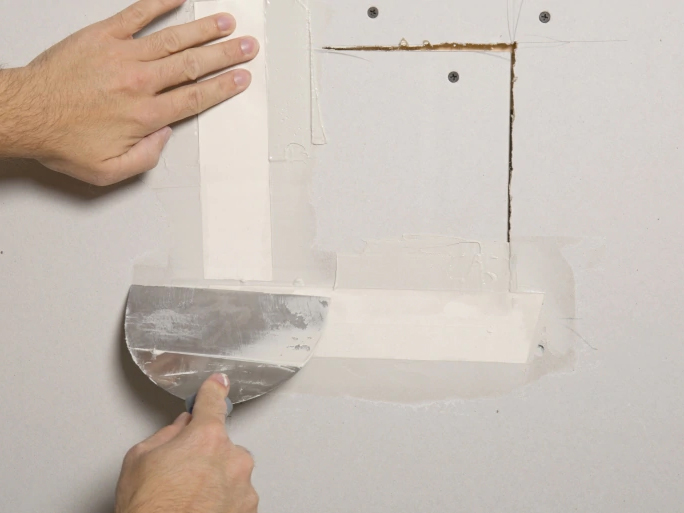Drywall is also referred to as gypsumboard, or plasterboard, and is used to construct walls and ceilings for interior spaces. It is constructed from the gypsum plaster core which is sandwiched between two layers of either paper or fiberglass.Drywall could require repaired for a variety of reasons, which include:
Drywall cracks and holes can easily be caused by doorknobs, furniture or accidental impacts, and even accidents.
Damage from water: Don't expose the drywall to water. It may become warped, discolored or moldy.
The foundation's setting or shifting could cause cracks to the walls.
Ageing: With time the drywall will become stiff and begin to show cracks or holes.
Plumbing or electrical work: When new plumbing or electrical wiring installation is made, holes might need to be cut into the wall and then patched.
Drywall repair involves filling the holes and cracks with joint compound, then sanding and then painting the drywall to match the surrounding areas. In certain instances it might be necessary to repair entire portions of drywall. It is crucial to take care of the drywall repair promptly to avoid further damage and maintain the appearance of your house or building. Read the top drywall calgary contractors examples for site advice including drywall mud and tape contractors, drywall near me contractor, drywall specialist near me, residential drywall contractors near me, drywall contractors in my area, commercial drywall contractors near me, drywall contractors near me, framing and drywall contractors, drywall specialist near me, sheetrock company and more.

What Happens To The Drywall What Can Be Done To Fix It? Fixed?
The process of repairing wallboard involves several steps. The process usually includes framing, insulation soundproofing, patching, taping mudding, and painting. This is a brief overview of Framing. The framing can require repair or replacement when the damage to the drywall results from structural issues.
Insulation After the framing is in place, insulation might need to be added to the wall cavity. This is especially important for walls on the outside or that separate living spaces.
Soundproofing If soundproofing is required, an additional layer of soundproofing material may be added between the framing material and drywall. This could reduce noise transmission between rooms.
Repair The damaged wall must be removed once the soundproofing, insulation, framing, and soundproofing are completed. Then, the drywall can be repaired. This might involve removing damaged sections and replacing them with new drywall.
Taping: When the new drywall is put in place, the joints of the drywall sheets need to be taped in order to create an even surface. Apply joint compound on the edges and cover the joints by a joint tape.
Mudding: Once the tape is applied to the surface, you must apply joint compound to fill in any gaps and smooth the surface. It is possible to apply several coats joint compound and sand between each coat to create an even surface.
Painting: Once the joint compound is dry and the surface is smooth, it's time to apply paint with a matching color to the walls or rooms surrounding it. To achieve the desired look, you may need to apply multiple coats of paint.
Although drywall repair can be lengthy however, it is possible to complete it with professionalism and care.

Here Are Some Helpful Tips And Suggestions To Choose A Drywall Contractor
Selecting the right contractor for your drywall is important to ensure that your project will be completed on time, within budget, and to an excellent standard. Here are some tips to help you choose a drywall company: Refer friends, family members and acquaintances. The recommendations of family and friends are the most reliable way to locate a reliable contractor.
It is also possible to research online and look up reviews on local drywall contractors via Google, Yelp or other review websites. This can help you assess their reputations and the quality and standards of their work.
Verify credentials: Make sure that the contractor you choose is licensed, insured, or bonded. This will protect you from any injuries or damages that could be caused during the course of the project.
Request estimates: Ask at least three contractors for written estimates. This will allow you to get a feel of the range of prices and help you identify any red flags.
Ask questions: Do not be afraid asking the contractor questions regarding their process, materials, and expertise. The best contractors will be able to be able to answer your concerns and provide a detailed explanation of how they work.
It is important to look for communicative abilities. Select a contractor who can be responsive and communicates well. This will help you ensure that the project goes smoothly and that you are pleased with the end result.
Review references: Request references and follow up with them. This will help you get an idea of the contractor's quality work as well as professionalism.
You can find a competent trustworthy, reliable, and a qualified contractor for drywall by following these tips.